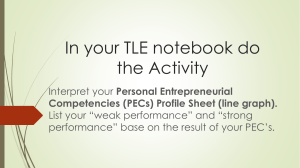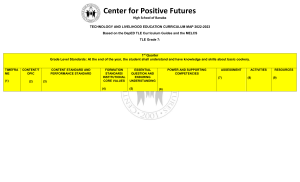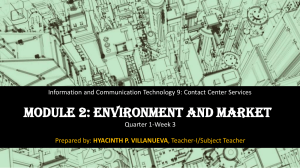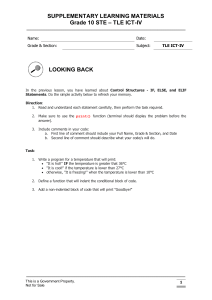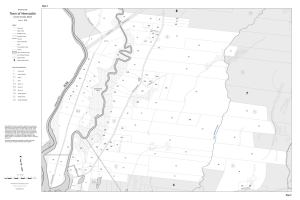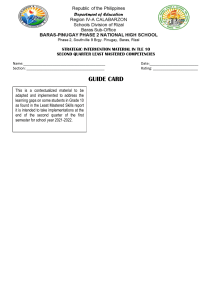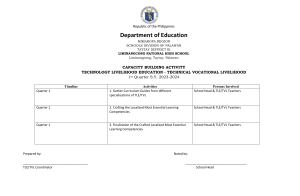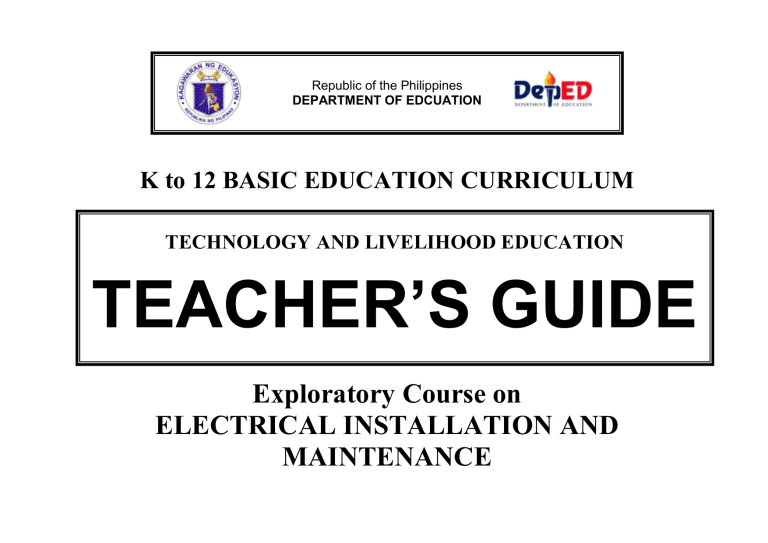
Republic of the Philippines DEPARTMENT OF EDCUATION K to 12 BASIC EDUCATION CURRICULUM TECHNOLOGY AND LIVELIHOOD EDUCATION TEACHER’S GUIDE Exploratory Course on ELECTRICAL INSTALLATION AND MAINTENANCE K to 12 TECHNOLOGY AND LIVELIHOOD EDUCATION INDUSTRIAL ARTS – ELECTRICAL INSTALLATION AND MAINTENANCE (Exploratory) Introduction.................................................................................................................................................................................................................. 3 Background Information The Overall Goal of the K to 12 Curriculum ....................................................................................................................................................... 3 The Conceptual Framework of the Teaching of TLE .......................................................................................................................................... 3 The TLE Exploratory Courses............................................................................................................................................................................ 5 The Learning Modules and Lessons ............................................................................................................................................................................ 6 New Feature of the Teaching of TLE ........................................................................................................................................................................... 6 About the Learning Module Design of the Module ......................................................................................................................................................................................... 7 Parts of the Lesson............................................................................................................................................................................................ 8 Reflection .................................................................................................................................................................................................................. 11 Curriculum Guide....................................................................................................................................................................................................... 12 *TWG on K to 12 Curriculum Guide – version January 31, 2012 2 K to 12 TECHNOLOGY AND LIVELIHOOD EDUCATION INDUSTRIAL ARTS – ELECTRICAL INSTALLATION AND MAINTENANCE (Exploratory) Teacher’s Guide for TLE Exploratory Course on Electrical Installation and Maintenance Introduction This Teacher’s Guide is intended for you, the TLE teacher, who teaches any of the more than 24 TLE exploratory courses in the Grades 7 and 8 of the K to 12 curriculum. To ensure that you teach the TLE exploratory courses the way they were intended to be taught, you must see the big picture of the K to 12 curriculum and the teaching of TLE. Some background information is necessary. Background Information 1. The Overall Goal of the K to 12 Curriculum The K to 12 Curriculum has as its overarching goal the holistic development of every Filipino learner with 21 st century skills who is adequately prepared for work, entrepreneurship, middle level skills development and higher education. The overarching goal of the K to 12 curriculum, tells you that the teaching of TLE plays a very important role in the realization of the overall goal of the curriculum. Whether or not the K to 12 graduate is skilled and ready for work, entrepreneurship and middle skills development depends to a great extent on how effectively you taught TLE. 2. The Conceptual Framework of the Teaching of TLE Below is a schematic diagram of Technology and Livelihood Education (TLE) framework in general secondary schools. This should guide you in the teaching of the TLE exploratory courses. *TWG on K to 12 Curriculum Guide – version January 31, 2012 3 K to 12 TECHNOLOGY AND LIVELIHOOD EDUCATION INDUSTRIAL ARTS – ELECTRICAL INSTALLATION AND MAINTENANCE (Exploratory) Figure 1.TLE Framework The diagram shows that Technology and Livelihood Education encompasses the field of Home Economics, Industrial Arts, Agri-Fishery Arts and ICT. The 24 TLE courses can be categorized under any of these fields. *TWG on K to 12 Curriculum Guide – version January 31, 2012 4 K to 12 TECHNOLOGY AND LIVELIHOOD EDUCATION INDUSTRIAL ARTS – ELECTRICAL INSTALLATION AND MAINTENANCE (Exploratory) TLE is geared towards the development of technological proficiency and is anchored on knowledge and information, entrepreneurial concepts, process and delivery, work values and like skills. This means that the TLE that works is one that is built on adequate mastery of knowledge and information, skills and processes, acquisition of right work values and life skills. The TLE that is functional is one that equips students with skills for lifelong learning. TLE that is concerned only with mere definition of terms is meaningless and shallow. TLE that is focused on mastery of skills and processes without right work values is anemic and dangerous. An effective TLE is one that is founded on the cognitive, behavioral or psychomotor and affective dimensions of human development. So when you teach TLE, teach facts, concepts, skills and values as a whole. The diagram likewise shows that entrepreneurial concepts also form part of the foundation of quality TLE. It is expected that your TLE students, after using the Learning Module on Entrepreneurship, imbibe the entrepreneurial spirit and consequently set up their own businesses in the areas of Agri-Fishery Arts, Industrial Arts, Home Economics, and Information and Communication Technology. TLE by its nature is dominantly a skill subject and so you must engage your students in an experiential, contextualized, and authentic teachinglearning process. It is a subject where your students learn best by doing. It is integrative in approach. For instance, it integrates entrepreneurship with all the areas of TLE. It integrates concepts, skills and values. 3. The TLE Exploratory Courses TLE in Grades 7 and 8 are exploratory in nature. Your school will choose at least 4 from the list of 24 courses for which 23 Learning Modules have been prepared. 1 Your school’s choice is determined by the availability of its resources (faculty and facilities) as well as the local needs and resources of the community. The 24 TLE exploratory courses focus on four basic common competencies as follows: 1) use and maintenance of tools and equipment; 2) mensuration and calculation; 3) occupational health and safety procedures, and 4) preparation and interpretation of technical drawing. Why b are these competencies called basic ? Because they are competencies that you must acquire in order that you can do higher level competencies . They are also described common because these are true to all TR-based TLE courses. 1 There are 24 TLE courses but there are only 23 Learning Modules because there is one Learning Module for Tailoring and Dressmaking. *TWG on K to 12 Curriculum Guide – version January 31, 2012 5 K to 12 TECHNOLOGY AND LIVELIHOOD EDUCATION INDUSTRIAL ARTS – ELECTRICAL INSTALLATION AND MAINTENANCE (Exploratory) The Learning Modules and Lessons There is a Learning Module for each exploratory course. If there are 24 exploratory courses then you have 24 Learning Modules in your hands. But you will use 4 Modules only for the entire year in Grade 7 (plus a fifth one on Entrepreneurship) and another 4 Modules in Grade 8 (plus a fifth one on Entrepreneurship). Each Learning Module consists of 4 to 5 Lessons2. The Lessons are focused on the 4 to 5 basic competencies. To avoid meaningless repetition of the teaching of the 5 common competencies, you have to teach them in the context of the TLE course. For example, you teach “use and maintenance of tools” in beauty care when you are teaching the course on Beauty Care. You teach the same competencies - use and maintenance of tools - in Horticulture but in the context of horticulture and so your tools will not be the same. New Feature on the Teaching of TLE What’s new in the teaching of TLE in the K to 12 curriculum? In the K to 12 curriculum, the TLE courses are taught based on the learning outcomes and performance criteria stated on the Training Regulations (TR) from Technical Education Skills and Development Authority (TESDA). They are TR-based. Why is this necessary? To prepare the K to 12 graduate for lucrative work, he/she must earn a National Certificate (NC) I, II or even an NC of higher level that is required by industry. This he/she earns after passing an assessment given by TESDA. How can you ensure that the K to 12 high school student (Grade 9 to 12) pass TESDA assessment and obtain an NC? By seeing to it that you teach the TLE course in accordance with the performance criteria and learning outcomes laid down in the TESDA Training Regulations. Do the exploratory courses enable the high school student to earn already an NC? Not yet. Completion of the exploratory courses may not yet qualify a high school student to take an assessment for an NC. Instead, it helps him/her earn a Certificate of Competency (COC) at least in Grade 9 that will lead eventually him/her to an NC. In short, the COC paves the way to the earning of an NC. Student’s choice of TLE specialization begins in Grades 9. After having been exposed to an array of TLE courses during the exploratory phase in the first two years, the student will be most benefited, if in Grades 10, 11 , or 12 he/she continues with a TLE course in which he/she already has a COC. In that way, he/she will get an NC faster. 2 Some Learning Modules combined use and maintenance of tools to make one Lesson, so the number of Lessons amount to 4; others made separate Lessons for use of tools and for maintenance of tools, thus the total is 5 Lessons. *TWG on K to 12 Curriculum Guide – version January 31, 2012 6 K to 12 TECHNOLOGY AND LIVELIHOOD EDUCATION INDUSTRIAL ARTS – ELECTRICAL INSTALLATION AND MAINTENANCE (Exploratory) About the Learning Module 1. Design of the Module a. The Module is designed to be a teacher-assisted learning kit or a self-learning kit on . competencies that a Grade 7 TLE ought to possess. It explores the course on Electrical Installation and Maintenance which helps your student earn a Certificate of Competency in Grade 9 which leads to a National Certificate Level I / II (NCI / II) in Grades 10, 11 or 12. b. The Learning Module is made up of 4 to 5 Lessons based on the competencies. Each Lesson contains the following: 1) Learning Outcomes 2) Performance Standards 3) Materials/Resources 4) Definition of Terms 5) What Do You Already Know? 6) What Do You Need to Know? 7) How Much Have You Learned? 8) How Do You Apply What You Learned? 9) What Is Your Score? 10) References There are some TLE Modules which have a section on “ How Do You Extend Your Learning?”. This section is meant for enrichment. It is usually given as an assignment for not everything can be taught and done in the classroom given the limited time. *TWG on K to 12 Curriculum Guide – version January 31, 2012 7 K to 12 TECHNOLOGY AND LIVELIHOOD EDUCATION INDUSTRIAL ARTS – ELECTRICAL INSTALLATION AND MAINTENANCE (Exploratory) 2. Parts of the Lesson - The following explain the parts of each Lesson, describe what your students’ task as well as your task. Part of the Lesson 1. 2. Students’ Task Teacher’s Task Learning outcomes are what your TLE student is supposed to know and be able to do after using the module. Since our TLE courses are TR-based, all learning outcomes written here are lifted from the TESDA TR. In the Curriculum Guide ( the matrix which contains Content Standard, Performance Standard, Learning Competencies, Projects/Activities, Assessment, Duration), the identified Learning Outcomes are written in the column of Learning Competencies. Students acquaint themselves with the learning outcomes and performance standards and make them their personal goals. You introduce the learning outcomes to your students and make sure that they understand them and make these learning targets their own . Performance Standards are referred to as “performance criteria” in the TESDA TR. They are more specific descriptions of the student’s behavior that serve as evidence that the expected learning outcomes have been realized with the expected level of proficiency or in accordance with established standards. Students clearly understand the performance standards and make them their own learning goals. You introduce the performance standards to your students and make sure that they understand them and make these performance standards their own . Make these your goals for instruction. Let these standards give your lesson its specific direction. The learning outcomes and performance standards set the direction of your lessons. These are what you should teach and, in *TWG on K to 12 Curriculum Guide – version January 31, 2012 8 K to 12 TECHNOLOGY AND LIVELIHOOD EDUCATION INDUSTRIAL ARTS – ELECTRICAL INSTALLATION AND MAINTENANCE (Exploratory) turn, what you should assess. They are identified and are written for you in the Curriculum Guide. 3. Materials and References To teach effectively, you need materials and references. Materials may include equipment, hand tools or consumables. The references are the books, magazines, articles, websites you yourself and your students will read or refer to in order to gain greater understanding of the lesson. They are either in soft copy or hard copy. Get to know the materials. They are part of the Lesson. By all means, read the references for lesson mastery. prepare the materials you need in advance. for gadget, tool or equipment, it is always wise to prepare, check and try them in advance to ensure that they function when you use them. as the saying goes “forewarned is forearmed.” Be resourceful in the preparation of materials. You are strongly encouraged to use appropriate local materials as substitute for listed materials that are not available. For effective teaching, your lesson preparation should include reading the list of references. Do not limit yourself to the list of reference. If you discover good reference material/s, add to the list of references. Introduce the references to your students. Motivate them to read these references as they go through the module for lesson mastery. 4. The definition of terms and acronyms will help you understand the meaning of key words in your lesson. Defining key words as they are used in your lesson will ensure that the key terms in your lesson mean one and the same for everyone in class and so avoid misunderstanding. Refer to the definition of terms for greater understanding of the lesson. Remind your students to refer to the definition of terms and acronyms for clearer understanding of the lesson. 5. The section “What Do You Already Take the test honestly. Tell your students to accomplish the pretest. Explain that *TWG on K to 12 Curriculum Guide – version January 31, 2012 9 K to 12 TECHNOLOGY AND LIVELIHOOD EDUCATION INDUSTRIAL ARTS – ELECTRICAL INSTALLATION AND MAINTENANCE (Exploratory) Know” is intended to determine entry knowledge and skills of your students to find out if you have to teach the lesson, teach some parts of the lesson or skip it entirely because your students already know it. This is done by way of a pretest. Check answers against the answer key provided. the purpose of the pretest is to find out how much they already know about the lesson in order to determine your next steps. It is, therefore, necessary that they take the test honestly, if they want to learn or want to be helped. Make it clear to them that their scores will not be recorded for grading purposes and will not be taken against them. If you find out that your students already know what you are about to teach, logic dictates that you do not need to teach it anymore. You may as well proceed to the next lesson. If, however, you find out that they do not yet know what you are about to teach, then by all means teach. Or if you discover that your students have some erroneous concepts, then teach and correct their misconceptions. To know what your students already know and do not yet know will guide you in adjusting your instruction. 6. “What Do You Need To Know?”- This section contains one or more Information Sheets and for some modules an Operation Sheet. These are important notes for the TLE student to read after which he/she is asked to do a Self-check to determine how much he/she has learned. The self-check functions as a pretest. Read and understand Information Sheet/s and Operation Sheet. 7. “How Do You Apply What You Learned?” – In this section, you give your Do the Activity. the /or Be prepared For a Self-check which serves as a posttest. Make sure students are engaged in reading the Information Sheet /Observation Sheet and in answering the self-check. Give assistance to your students where needed. Correct answers by referring to the answer key. *TWG on K to 12 Curriculum Guide – version January 31, 2012 Find a way to test real life application of what your students have learned. 10 K to 12 TECHNOLOGY AND LIVELIHOOD EDUCATION INDUSTRIAL ARTS – ELECTRICAL INSTALLATION AND MAINTENANCE (Exploratory) student the opportunity to transfer what he/she has learned in another activity or in real life situation. Ideally, this should be a performance test, what you usually call practical test. If “the proof of the pudding is in the eating”, then your student must be able to apply what she/he learned in reallife setting or must be able to come up with a product as an evidence of learning. 8. How Do You Extend Your Learning? – As the word implies, this activity is done outside class hours for enrichment purposes. This can reinforce lesson mastery. To determine level of performance, use the scoring rubrics or check answers against the answer key, whichever is applicable? Do not hesitate to use ways of determining how your students can apply learned facts and concepts which are more authentic and realistic than that/those given in the Module. Reflect on assessment results. Reflect on assessment results. Use in planning your instruction. assessment results Do the task assigned outside class hours. Motivate the students to do the task by making clear what the enrichment activity is about – why it is given, how it is done, how it relates to the class lesson . Reflection It is a good habit to reflect on your teaching for the day – what went well, what did not go well, why this activity went well with this group, why it didn’t work well with the other group. What are your realizations? What are lessons learned? Jot them down in your diary. Commit them to your memory. If you do this consistently, you will find your delivery improve substantially. *TWG on K to 12 Curriculum Guide – version January 31, 2012 11 K to 12 TECHNOLOGY AND LIVELIHOOD EDUCATION INDUSTRIAL ARTS – ELECTRICAL INSTALLATION AND MAINTENANCE (Exploratory) Curriculum Guide for the Exploratory Course on Electrical Installation and Maintenance For you to get a complete picture of the complete TLE exploratory course on Electrical Installation and Maintenance, you are hereby provided with the Curriculum Guide on Electrical Installation and Maintenance. Content Standard Performance Standard Learning Competencies Project/ Activities Assessment Duration LESSON 1: PREPARE ELECTRICAL MATERIALS AND TOOLS Demonstrate understanding of/on: Identify supplies, materials and tools applicable to a specific job Electrical tools and equipment Electrical supplies and materials Common splices and joints Extension cord 1. Tools and materials are identified as per job requirement. 2. Tools are classified according to their function as per job requirements. 3. Materials are classified according to their uses to a specific project. 4. Tools and materials are selected as per job requirement. *TWG on K to 12 Curriculum Guide – version January 31, 2012 LO1. Identify electrical supplies materials and tools 1. Skinning wires using the following tools: a. electricians knife, b. combination pliers &side cutting pliers, c. wire Stripper. Perform operation sheet 1.2A 2. Connecting the skinned wires to the terminals of: a. bulb receptacles, b. switches, and c. fuse boxes. Perform operation sheet 1.2B 3. Perform Splices and joints, 4. Perform operation sheet 1.3A,B, Make an Written test Performan ce test 12 hours 12 K to 12 TECHNOLOGY AND LIVELIHOOD EDUCATION INDUSTRIAL ARTS – ELECTRICAL INSTALLATION AND MAINTENANCE (Exploratory) Content Standard Different types of forms Requisition Slip Inventory of Materials Form Sample Job order form Equipment Borrower’s Form Procedures in receiving and inspecting tools and materials Proper inspection of tools and materials received. Performance Standard Learning Competencies 1. Needed materials and tools are listed as per job requirement. 2. Materials and tools are requested according to the list prepared. 3. Requests are done as per company standard operating procedures (SOP). 4. Materials and tools are substituted provided required materials and tools are unavailable without sacrificing cost and quality of work. LO2. Request appropriate electrical supplies materials and tools applicable to a specific job 1. Materials and tools are received and inspected as per quantity and specification based on requisition. 2. Tools and materials are checked for damages and manufacturing defects. 3. Materials and tools received are handled with appropriate safety devices. 4. Materials and tools are set aside to appropriate location nearest to the workplace. LO3. Receive and inspect electrical supplies, materials and tools *TWG on K to 12 Curriculum Guide – version January 31, 2012 Project/ Activities Extension Cord (see project plan) 1. Identify different types of forms use in the shop and explain how it is being used. 2. Simulate student to act as tool keeper and the other is a borrower. Simulation: a. One student act as a supplier and the other as the receiver of supplies Assessment Duration Direct observation Written test Performanc e test Direct observation Direct observation Written test Performanc e test 13 K to 12 TECHNOLOGY AND LIVELIHOOD EDUCATION INDUSTRIAL ARTS – ELECTRICAL INSTALLATION AND MAINTENANCE (Exploratory) Content Standard Performance Standard Learning Competencies Project/ Activities Assessment Duration LESSON 2: PERFORM MENSURATIONS AND CALCULATIONS Demonstrate understanding of/on: Measuring tools and Instruments Proper handling of measuring instruments Ohms Law System of measurement English Metric Converting the unit of measurement from English to Metric and vice versa The Multi Tester Proper Care and Maintenance How to read the scale 1. Measuring tools are selected/classified as per object to be measured on job requirements. 2. Measurements are obtained according to job requirements. 3. Computation for resistance, current and voltage using Ohms Law are obtained. LO1.Select electrical measuring tools and instruments. 1. Numerical computations are self-checked and corrected for accuracy. 2. Accurate measurements are obtained according to job requirements. 3. Identified and converted systems of measurement according to job requirements. 4. Measured work pieces according to job requirements. LO2.Carry out measurements and calculations. *TWG on K to 12 Curriculum Guide – version January 31, 2012 1. measurement of: a. teachers table, b. the classroom. 1. Measure the ff.: a. Voltage of the outlet, b. Voltage of a dry cell battery, and c. Resistance of resistors. Take the following measurements: Teacher’s Table Length of Eraser Height of Cabinet 3. Reading a Voltmeter 4. Reading Ohmeter Actual demonstrati on Direct observation Written test Performanc e test 6 hours Direct observation Written test Performanc e test 14 K to 12 TECHNOLOGY AND LIVELIHOOD EDUCATION INDUSTRIAL ARTS – ELECTRICAL INSTALLATION AND MAINTENANCE (Exploratory) Content Standard Performance Standard Learning Competencies Project/ Activities Assessment Duration LESSON 3: INTERPRET TECHNICAL DRAWINGS AND PLANS Demonstrate understanding of/on: Common Electrical Symbols Electrical Signs 1. Electrical symbols and Sign are identified according to job specifications. 2. Electrical symbols and Sign are determined according to classification or as appropriate in drawing. LO1. Analyze signs, electrical symbols and data. Electrical Wiring Diagram Pictorial Diagram Schematic Diagram Types of Circuit Series Circuit Parallel Circuit 1. Necessary tools, materials and equipment are identified according to the plan. 2. Components, assemblies or object are recognized as per job requirement. 3. Dimensions and specification are identified according to job requirements. LO2. Interpret technical drawings and plans. Electrical plan Quantity of Electrical Fixture Draw Schematics Diagram Symbols *TWG on K to 12 Curriculum Guide – version January 31, 2012 1. Draw the different signs commonly used in the industry in illustration board or any hard carton board. 2. Identify the different electrical symbols a. Do activity sheet 1.1 1. Draw schematic diagrams (electrical plan) Direct observation Written test Performanc e test 6 hours Direct observation Written test Performanc e 15 K to 12 TECHNOLOGY AND LIVELIHOOD EDUCATION INDUSTRIAL ARTS – ELECTRICAL INSTALLATION AND MAINTENANCE (Exploratory) Content Standard Performance Standard Learning Competencies Project/ Activities Assessment Duration LESSON 4: MAINTAIN TOOLS AND EQUIPMENT Demonstrate understanding of/on: Classification of Tools and Equipments Hand tools Machine/Power Tools Basic Maintenance of Electrical Tools and Equipment Classification of functional and nonfunctional tools Methods of Identfying non-functional tools and equipment Classification of Tools and equipment according to their uses 1. Tools and equipment are identified according to classification/ specification and job .requirements. 2. Non-functional tools and equipment are segregated and labeled according to classification. 3. Safety of tools and equipment are observed in accordance with manufacturer’s instructions 4. Conditions of PPE are checked in accordance with manufacturer’s instructions. LO1. Check condition of tools and equipment. Definition of Lubricant Types uses of lubricants Characteristics of Lubricant Types and uses of cleaning solvent 5S Approach in workshop keeping 1. Lubricants are identified according to types of equipment. 2. Tools and equipment are lubricated according to preventive maintenance schedule or manufacturer’s specifications. LO2. Perform basic preventive maintenance. *TWG on K to 12 Curriculum Guide – version January 31, 2012 1. Basic Maintenance of Electrical tools and Equipment 2. Identify functional and Non-Functional tools and Equipment 1. Perform cleaning and lubricating of tools 2. Perform 5’s. Direct observation Written test Performanc e test 8 hours Direct observation Written test Performanc e test 16 K to 12 TECHNOLOGY AND LIVELIHOOD EDUCATION INDUSTRIAL ARTS – ELECTRICAL INSTALLATION AND MAINTENANCE (Exploratory) Content Standard Performance Standard OSHC workplace regulations Preventive maintenance techniques and procedures. 3. Measuring instruments are checked and calibrated in accordance with manufacturer’s instructions. 4. Tools are cleaned and lubricated according to standard procedures 5. Defective equipment and tools are inspected and replaced according to manufacturer’s specification. 6. Work place is cleaned and kept in safe state in line with OSHC regulations. Why maintain Inventory of Tools and Equipment Maintaining and Storing Hand Tools and Power Tools and Equipment Sample of Proper Arrangement of Tools and Equipment Tool safe-keeping/storage 1. Inventory of tools, instruments, and equipment are conducted and recorded as per company practices. 2. Tools are inspected, and replaced if found defective 3. Tools and equipment are stored safely in accordance with manufacturer’s specifications or company procedures. *TWG on K to 12 Curriculum Guide – version January 31, 2012 Learning Competencies LO3. Store tools and equipment. Project/ Activities 1. Preparing inventory of tools and equipment (Operation Sheet 3.1, 3.2) Assessment Duration Practical exam Direct observation Written test 17 K to 12 TECHNOLOGY AND LIVELIHOOD EDUCATION INDUSTRIAL ARTS – ELECTRICAL INSTALLATION AND MAINTENANCE (Exploratory) Content Standard Performance Standard Learning Competencies Project/ Activities Assessment Duration LESSON 5: PRACTICE OCCUPATIONAL HEALTH AND SAFETY PROCEDURES Demonstrate understanding of/on: Hazards and risks What is the difference between Hazards and Risks Five Basic Workplace Hazards What are examples of Hazard Threshold limit value (TLV) 1. Workplace hazards and risks LO1. Identify are identified and clearly hazards and explained. risks. 2. Hazards/risks and their corresponding indicators are identified in with the company procedures. 3. Contingency measures are recognized and established in accordance with organizational procedures. 1. Perform Job Sheet Making an internet research on different company hazards and risks. Written test What is a Risk Assessment? Threshold limit value (TLV) Fire And Explosion Hazard Assessment Philippine Clean Air Act Effects of hazards in the workplace Ergonomics ECC Regulations 1. Terms of maximum tolerable limits are identified based on threshold limit values (TLV). 2. Effects of hazards are determined. 3. OHS issues and concerns are identified in accordance with workplace requirements and relevant workplace OHS legislation. LO2. Evaluate hazards and risks. 1. Present a video regarding workplace hazards and risk. 2. Simulation depicting hazards and risks tion Written test Performa nce test Hazard Control Identify the Hazard 1. OHS procedures for controlling hazards and risk are strictly LO3. Control hazards and *TWG on K to 12 Curriculum Guide – version January 31, 2012 1. Do activity sheet 3.1 8hours Written test 18 K to 12 TECHNOLOGY AND LIVELIHOOD EDUCATION INDUSTRIAL ARTS – ELECTRICAL INSTALLATION AND MAINTENANCE (Exploratory) Content Standard Performance Standard Assess the risk Eliminate Hazard and Risk Engineering Control Administrative Control PPE’s Your Health and Safety at Work Workplace First Aid Facility Emergency Preparedness followed. 2. Procedures in dealing with workplace accidents, fire and emergencies are followed in accordance with the organization’s OHS policies. 3. Personal protective equipment (PPE) is correctly used in accordance with organization’s OHS procedures and practices. 4. Procedures in providing appropriate assistance in the event of workplace emergencies are identified in line with the established organizational protocol. Learning Competencies risks and practice Occupational Health and Safety Project/ Activities Assessment Duration a. Poster making on safety rules and regulations b. Proper waste management exercises 40 hours “By three methods we may learn wisdom: First, by reflection, which is noblest; second, by imitation, which is easiest; and third by experience, which is the bitterest.” - Confucius *TWG on K to 12 Curriculum Guide – version January 31, 2012 19
